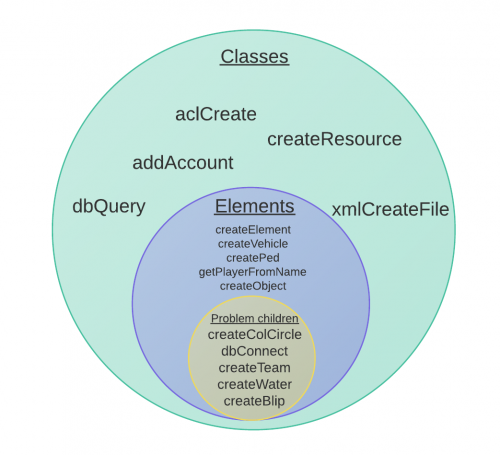OOP Introduction: Difference between revisions
(Created page with "This is a scripting tutorial explaining to you what object orientated programming is and teaching you how to use the OOP features of MTA. This was originally created by ~~~~ ...") |
No edit summary |
||
| Line 49: | Line 49: | ||
end | end | ||
setTimer(incrementDimension, 60*1000, 10) | setTimer(incrementDimension, 60*1000, 10) | ||
</syntaxhighlight> | </syntaxhighlight> | ||
This code would take a random player and move them to the next dimension every minute for the next ten minutes. | This code would take a random player and move them to the next dimension every minute for the next ten minutes. | ||
Revision as of 22:49, 8 June 2014
This is a scripting tutorial explaining to you what object orientated programming is and teaching you how to use the OOP features of MTA. This was originally created by qaisjp (talk) 22:48, 8 June 2014 (UTC)
Introduction to OOP
OOP stands for object orientated programming. Three simple words, and you'll probably understand the last word the most. OOP is where all functions relating to a single instance are called on that instance, an instance being a creation of a class - an element class, a database class, a player, a vehicle. Originally, everything was procedural, you had to do things like:
local vehicle = createVehicle(411, 0, 0, 3) setVehicleDamageProof(vehicle) setElementFrozen(vehicle) setElementHealth(vehicle, 1000) setElementVelocity(vehicle, 0.2, 0.2, 0.2) destroyElement(vehicle)
More often than not, you know what you're dealing with. The variable almost always links back to the type, you would name a vehicle that exploded as explodedVehicle, or at-least in context you would understand that exploded implies a vehicle when in the onVehicleExplode event. So you have to write a long function and refer to the vehicle manually when working procedurally. Painful. Object orientated programming is very different to this and works with each "object" individually. Instead of having to call a function and referencing it inside the call, you actually call the function INSIDE the class.
You probably think everything you can create and pass to functions are elements. A vehicle is an element. A player is an element. Anything that is an element is also a class. Connections create an instance of a class, but "connection" isn't an element, it's an instance - an object. Throughout the tutorial when I say object, I don't mean createObject (unless I actually mention it, but to make things clearer I will avoid mentioning physical objects as I write this article. Here is a fancy venn diagram I created to show the simple organisation of classes and elements.
The functions on the left are sorted to show what kind of category the returned value rests in. We've got Classes, Elements and "Problem children". Problem children aren't real categories written in the code, just functions that break rules. Everything you can play with are classes: resources, vehicles, and teams.
All elements are classes, you can do:
destroyElement(ped)
but you can't do:
destroyElement(resource)
Problem children are weird things. You can't do all the functions mentioned in (actually, all elements don't allow the full assortment of functions to be applied to them, but I've especially mentioned a few of them) in the "Element functions" section of the functions list, but you can do destroyElement() on them. There are children of classes, for example, with players, the system goes like: Element -> Ped -> Player". All Players are Peds and all Peds are Players. Not all Peds are Players, and certainly not all Elements are Players. The main point here is that almost everything that you can create or retrieve and then reuse later use a class.
Instead of the code before, the code could be replaced with this:
local vehicle = createVehicle(411, 0, 0, 3) vehicle:setDamageProof(vehicle) vehicle:setFrozen(vehicle) vehicle:setHealth(1000) vehicle:setVelocity(0.2, 0.2, 0.2) vehicle:destroy()
It works pretty similar to how a table works, it's just like customTable.setSomething() except the use of : makes Lua convert customTable:setSomething() convert to customTable.setSomething(customTable). This is pretty internal stuff about syntactic sugar and you don't really need to worry much about it.
Those functions are pretty useful, but there are more changes with OOP, I'll explain this below.
Enabling OOP
By default, object orientating programming is disabled - this is mainly because the vast majority of servers will prefer to stick to what they know - same old boring procedural functions. Of course, to support the great backwards-compatible-code feature of MTA, the old functions will always work and will never get removed (or atleast not in the near future). Even with OOP enabled everything will "just work". So, to enable OOP it's as simple as setting
<oop>false</oop>
in the server configuration to 'true.
Instantiation, variables
OOP removes the need to say the "create" part of the function, so instead of saying createVehicle, you just say Vehicle. It works exactly the same way, it's almost just like doing Vehicle = createVehicle. Fancy, isn't it? The only difference here is that you miss out on the extra things offered, Vehicle doesn't have these extra things, but Player definitely does. For example, instead of doing getPlayerFromName(), you would do Player.getFromName(). It's a nice and simple way to organise functions.
Since OOP sits on top of procedural, many things have been inherited from the style of procedural, but to make things easier we have variables for all the functions that require a single input. We've shortened getElementDimension() down to element:getDimension(), but we can also go one layer deeper: element.dimension. Yep, just like a variable. You can set this variable just like a normal variable and read from it just like a normal variable. Hey, you could even do this:
local function incrementDimension()
local player = Player.getRandom()
player.dimension = player.dimension + 1
end
setTimer(incrementDimension, 60*1000, 10)
This code would take a random player and move them to the next dimension every minute for the next ten minutes.
Vectors
-- incomplete
